spring的Bean注入和P标签使用
[spring]xml配置文件中bean属性的两种写法(p:configLocation <=> <property name=”configLocation”/>)
p:configLocation:
<!– mybatis文件配置,扫描所有mapper文件 –>
<bean id=”sqlSessionFactory” class=”org.mybatis.spring.SqlSessionFactoryBean”
p:dataSource-ref=”dataSource”
p:configLocation=”classpath:mybatis-config.xml”
p:mapperLocations=”classpath:com/eliteams/quick4j/web/dao/*.xml”/>
<property name=”configLocation”/>:
复制代码
<bean id=”sqlSessionFactory” class=”org.mybatis.spring.SqlSessionFactoryBean”>
<property name=”dataSource” ref=”dataSource”/>
<!– mapper和resultmap配置路径 –>
<property name=”classpath:com/eliteams/quick4j/web/dao/*.xml” />
<property name=”configLocation” value=”classpath:mybatis-config.xml”/>
</bean>
复制代码
注:org.mybatis.spring.SqlSessionFactoryBean:
SqlSessionTemplate中需要的是SqlSessionFactory,而不是SqlSessionFactoryBean。这个是因为SqlSessionFactoryBean继承了FactoryBean<SqlSessionFactory>
在spring的bean配置文件中我们常可以见到下面的例子:
<bean id=”boss” class=”com.zj.Boss” scope=”prototype” p:name-ref=”name”>
</bean>
其中,p:name-ref=”name”使用了p标签来配置bean的name的引用。
在使用p标签配置bean的属性时,我们先要声明p标签的命名空间xmlns:p=”http://www.springframework.org/schema/p”。
然后,使用p标签时分两种情况。
第一种配置基本类型的属性:p:name=“zhujun”
第二种配置引用类型的属性:p:name-ref=“name”;
注意,在配置引用类型的属性时在属性后加上ref表明我要配置的属性时引用类型。
1.构造方法参数 对应 配置文件 <constructor-arg> 元素
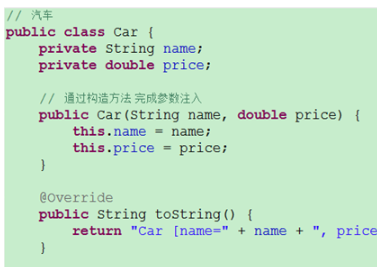
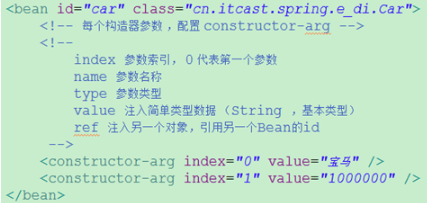
可以index|name|type 三选一 、三选二 ; ref|value 二选一
2. setter方法注入(开发推荐)
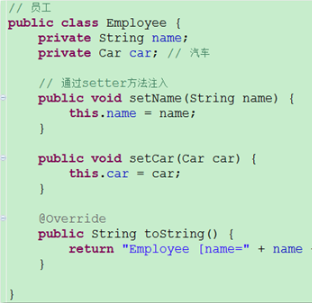
为需要注入属性提供setter方法
配置 每个注入属性, 对应<property> 元素
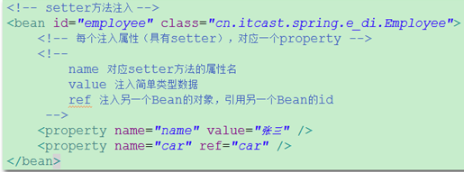
3. p名称空间的使用
spring2.5以后,为了简化setter方法属性注入,引用p名称空间的概念,可以将<property> 子元素,简化为<bean>元素属性配置 !!
在applicationContext.xml 引入p 名称空间
<beans xmlns=”http://www.springframework.org/schema/beans”
xmlns:p=”http://www.springframework.org/schema/p”
xmlns:xsi=”http://www.w3.org/2001/XMLSchema-instance”
xsi:schemaLocation=”
http://www.springframework.org/schema/beans
http://www.springframework.org/schema/beans/spring-beans.xsd”>
b. 简化注入的配置
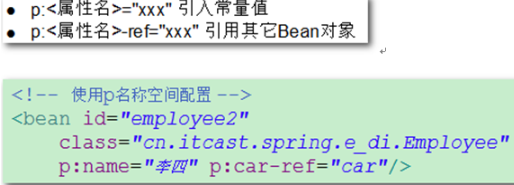
4. 集合类型的属性注入(了解)
Spring 对每个常用集合对象,提供单独元素完成注入
List 对象 —- <list> 元素
Set 对象 —- <set> 元素
Map对象 —-<map>元素
Properties 对象 —- <props> 元素
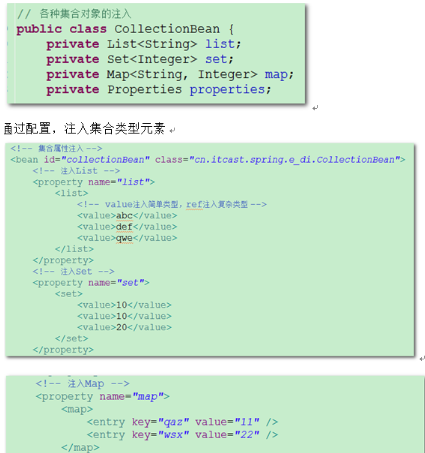
集合属性的注入,主要用于框架的配置 !
来源: https://www.cnblogs.com/xumaodun/p/4928136.html










![[HBLOG]公众号](https://www.liuhaihua.cn/img/qrcode_gzh.jpg)

